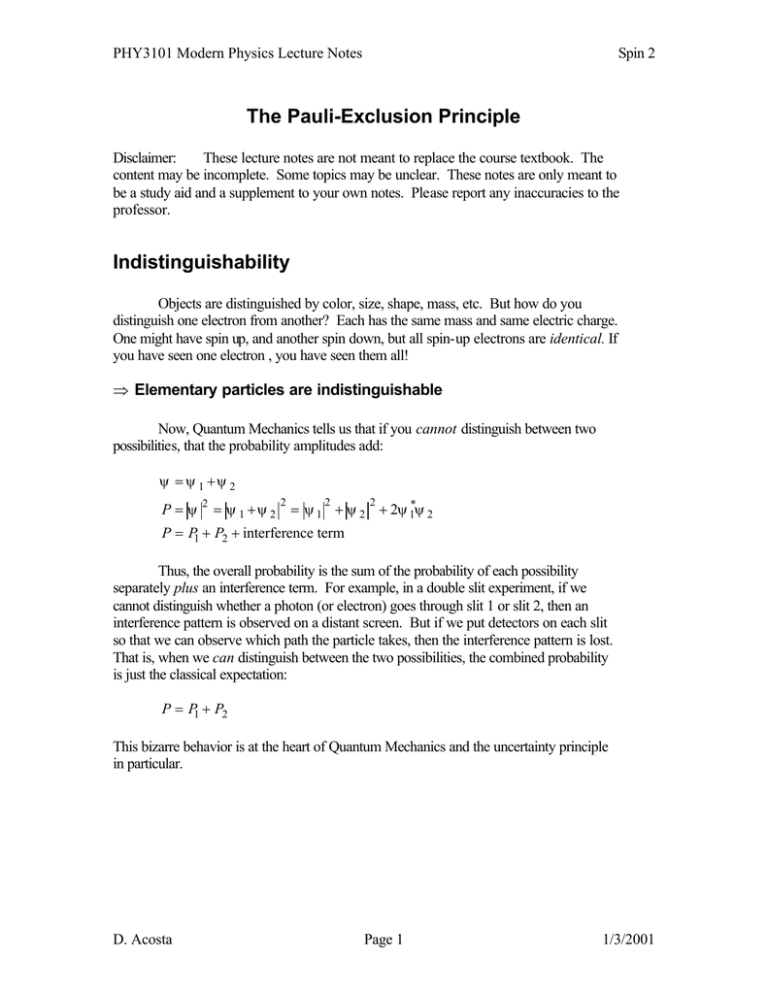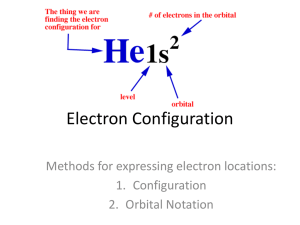The Pauli-Exclusion Principle
advertisement

PHY3101 Modern Physics Lecture Notes Spin 2 The Pauli-Exclusion Principle Disclaimer: These lecture notes are not meant to replace the course textbook. The content may be incomplete. Some topics may be unclear. These notes are only meant to be a study aid and a supplement to your own notes. Please report any inaccuracies to the professor. Indistinguishability Objects are distinguished by color, size, shape, mass, etc. But how do you distinguish one electron from another? Each has the same mass and same electric charge. One might have spin up, and another spin down, but all spin-up electrons are identical. If you have seen one electron , you have seen them all! ⇒ Elementary particles are indistinguishable Now, Quantum Mechanics tells us that if you cannot distinguish between two possibilities, that the probability amplitudes add: ψ = ψ 1 +ψ 2 P=ψ 2 = ψ 1 +ψ 2 2 2 2 = ψ 1 + ψ 2 + 2ψ 1*ψ 2 P = P1 + P2 + interference term Thus, the overall probability is the sum of the probability of each possibility separately plus an interference term. For example, in a double slit experiment, if we cannot distinguish whether a photon (or electron) goes through slit 1 or slit 2, then an interference pattern is observed on a distant screen. But if we put detectors on each slit so that we can observe which path the particle takes, then the interference pattern is lost. That is, when we can distinguish between the two possibilities, the combined probability is just the classical expectation: P = P1 + P2 This bizarre behavior is at the heart of Quantum Mechanics and the uncertainty principle in particular. D. Acosta Page 1 1/3/2001 PHY3101 Modern Physics Lecture Notes Spin 2 Now let’s apply this rule to the scattering of distinguishable and indistinguishable particles. Consider Rutherford scattering of α-particles off gold nuclei. α α Au θ α Au Au π-θ Au α The two possibilities are easily distinguished from one another because we can tell the difference between an α-particle and a gold nucleus. The scattering rate is given by the Rutherford formula, and it depends on the scattering angle: bg Rate ∝ f θ 2 ∝ 1 sin4 θ / 2 But what about the scattering between two α-particles? α α α θ α α α π-θ α α All you can detect is the outgoing particles, which are indistinguishable. The uncertainty principle prevents us from knowing what is going on at the collision vertex. If we tried to observe which reaction took place, we would disturb the reaction so that it didn’t take place! Another way of saying this is that the wavefunctions overlap at the vertex. So, we cannot know which possibility took place for the given set of angles. Thus, Quantum Mechanics says that we must add the two scattering amplitudes: bg b Rate ∝ f θ + f π − θ g 2 bg ≠ f θ 2 In other words, the scattering of identical particles (α-α) gives a different rate (and even a different angular dependence) than for distinguishable particles (α-Au) aside from just the different atomic numbers Z. This has been confirmed experimentally many times! It is another example of Quantum Mechanics predicting something different than we expect classically. D. Acosta Page 2 1/3/2001 PHY3101 Modern Physics Lecture Notes Spin 2 We run into the same sort of indistinguishable possibilities when we try to describe the wavefunction for the helium atom, which has two electrons bound to the nucleus. The wavefunction should describe the probable locations for electron 1 and electron 2. b g b g where ψ = R br gY bθ , φ g ψ 12 = ψ 1 x1 ψ 2 x2 nl i i lm i i assuming hydrogen orbitals for the moment This wavefunction describes electron 1 at position x1 and electron 2 at position x2 . But this cannot be distinguished from the case where electron 2 is position x1 and electron 1 is at position x2 : b g b g ψ 21 = ψ 2 x1 ψ 1 x 2 The two possibilities are drawn schematically below: e1 • ⊕ x1 e2 e2 • • x2 x1 ⊕ e1 • x2 Again, if we cannot distinguish between two possibilities, the rule in Quantum Mechanics says that we must “add” both possibilities: ψ = ψ 12 + ψ 21 We say that the wavefunction should be symmetric in particle indices. Now, Nature has one more twist in store for us! It turns out that we could also have subtracted the two wavefunctions rather than added them. The only thing that would change is the sign of the interference term, but interference would still occur. It turns out that both cases (adding or subtracting probability amplitudes) occur in Nature, and the rule for selecting which case depends on the particle spin. D. Acosta Page 3 1/3/2001 PHY3101 Modern Physics Lecture Notes Spin 2 Bosons: If the identical particles involved have integral spin ( s = 0,1,2 ,... ), then the rule for adding probability amplitudes is: ψ = ψ 12 + ψ 21 P=ψ 2 2 2 * = ψ 12 + ψ 21 + 2ψ 12ψ 21 Another way of stating the rule is that the wavefunction must be symmetric under particle interchange: b g b ψ x 1, x 2 = ψ x 2 , x 1 g The statistics of integral spin particles were studied by Satyendra Nath Bose, and thus such particle are referred to as bosons. Fermions: If the identical particles involved have half-integral spin ( s = 1 3 5 , , ,... ), then 2 2 2 the rule for “adding” probability amplitudes is to subtract them: ψ = ψ 12 − ψ 21 P=ψ 2 2 2 * = ψ 12 + ψ 21 − 2ψ 12ψ 21 Another way of stating the rule is that the wavefunction must be anti-symmetric under particle interchange: b g b ψ x1, x2 = −ψ x2 , x1 g The statistics of half-integral spin particles were studied by Enrico Fermi, and thus such particle are referred to as fermions. Example: Let’s consider again helium. We know that electrons have spin 1/2, so they are fermions. The wavefunction describing both electrons must therefore be antisymmetric. Suppose both electrons have the same spin orientation (say spin-up). Then the spatial part of the wavefunction satisfies: ψ x1, x2 = −ψ x2 , x1 b g b g What happens if x1 = x 2 ? The only solution is ψ = 0 . There is zero probability for two electrons to be in the same location. D. Acosta Page 4 1/3/2001 PHY3101 Modern Physics Lecture Notes Spin 2 Pauli-Exclusion Principle No two fermions with the same spin may occupy the same position in space. In the context of multi-electron atoms, no two electrons in an atom may have the same set of quantum numbers: n, l, ml , ms If we assume that the electrons are in hydrogen-like orbitals, then the wavefunction is anti-symmetric: bg b g b g b g b g b g bg b ψ = Rnl r1 Ylm θ 1, φ 1 Rn 'l ' r2 Yl 'm' θ 2 , φ 2 − Rnl r2 Ylm θ 2 , φ 2 Rn 'l ' r1 Yl 'm' θ 1 , φ 1 g when both sets of quantum numbers are the same, the overall wavefunction is obviously zero. This is an important fundamental result, and it come from a deep connection between identical particles and spin. This principle, as we will see, is responsible for atomic structure (and thus all of chemistry!) and nuclear structure. However, the PauliExclusion Principle only applies to fermions. If the particles are bosons (integral spin) then they are not affected. You can put as many bosons in the same state as you like. D. Acosta Page 5 1/3/2001 PHY3101 Modern Physics Lecture Notes Spin 2 Atomic Structure The Schrodinger Equation in principle can be used to solve exactly for the wavefunction and energy levels of multi-electron atoms (helium and beyond), something the Bohr model could not do. In practice, the equations cannot be solved exactly. The reason is that this is a many-body problem, and the mathematics are very difficult. To illustrate the point, consider helium. The potential energy can be written: V= − Ze2 − Ze 2 e2 + + 4πε 0 r1 4πε 0 r2 4πε 0 r1 − r2 The last term from the Coulomb repulsion of the two electrons makes the separation of variables technique to solve the Schrodinger Equation impossible. However, if we could neglect this term, then the solutions are already known! They are just the hydrogen orbitals (one for each electron). The overall solution would just be the anti-symmetric combination of hydrogen orbitals. Thus, we can obtain an approximate solution and learn a lot about atomic structure if we just neglect electron repulsion compared to the nuclear attraction. The ground state solution is approximated by filling hydrogen orbitals with electrons starting with the lowest available, but taking into consideration the Pauli-Exclusion principle. So for helium (Z = 2), if you want both electrons in the ground state ( n = 1, l = 0 ), one electron must have spin-up and the other spin-down. For lithium (Z = 3), the third electron must go into the first excited state of the hydrogen atom (n = 2, l = 0 ) Continuing on in this way, we find the following atomic structure: H: 1s1 He: 1s 2 Closed n = 1 shell Li: 1s2 2 s1 Be: 1s 2 2s 2 Closed n = 2, l = 0 subshell B: 1s 2 2s 2 2 p1 C: 1s 2 2 s 2 2 p 2 N: 1s 2 2s 2 2 p 3 O: 1s2 2 s 2 2 p4 F: 1s 2 2 s2 2 p 5 Ne: 1s 2 2s 2 2 p 6 D. Acosta Closed n = 2 shell Page 6 1/3/2001 PHY3101 Modern Physics Lecture Notes Spin 2 Atoms with closed subshells tend to be more tightly bound (and more chemically inert) than atoms with valence electrons (electrons in outer subshell). In fact, those atoms with similar chemical properties have the same valence structure. Thus, we can derive the organization of the Periodic Table (first written down by Dmitri Mendeleev in 1869) based on the solution to the Schrodinger Equation coupled with the Pauli-Exclusion principle. Groups: Similar chemical properties, same valence structure: inert gases (closed subshell), alkalis (one outer valence electron), halogens (lack one electron from closed subshell) Periods: Filling of subshells Group Period D. Acosta Page 7 1/3/2001






